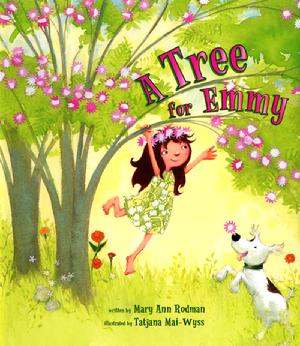 |
| Peachtree Publishers--Atlanta |
|
Our Winning Book Synopsis
The story begins as we see a girl named Emmy enjoying a ride on a tire swing, suspended in the shade of one of her favorite trees--her dog resting near the tree's massive trunk.
We think this 2011 Giverny Award-winning book will inspire joyful observation, comparison, and appreciation of trees--both cultivated and introduced--for children in the age-band (ages 4 to 8) that is typically served by children's science picture books.
It couples sound botanical content with green-dominant watercolors and collage-type illustrations depicting the wonder of trees that motivate the little girl in the story.
The evocative and fanciful artwork captures the inviting play-time surroundings that trees provide in the spring and summer months--through artwork that is both intimate and familial. We see that beauty, plants, and botany intersect in ways that can fascinate a child at play.
The book's carefully chosen science content shows young readers that trees can be an important part of the adventures of childhood, and that they, like children, start off small when they are young, but change and increase in size over time. We also learn that trees repay careful observation.
The book's artistic device is to portray the human-human and human-plant interactions that have sparked and supported Emmy's love of trees--and in particular, her love for the mimosa tree.
The variety of visual perspectives the book offers of these interactions, coupled with the text's botanical and social reasons that Emmy prefers to have her own home-grown mimosa tree over all the other cultivated trees she's seen so far, make this book a delight to read.
The young reader also learns how a tree species not commericially available, the mimosa tree or silk tree, Albizia julibrissin, was harvested as a seedling growing beneath a mature specimen plant ("Grandma's tree"), transported carefully, potted, and then successfully cultivated outdoors.
We especially liked the injection of 1- and 2-page spreads, close-ups, 4-shot series, and high- and low- perspective illustrations for visual variety. Small visual details of the mimosa tree and the visual capture of Emmy's emotional attachment to her favorite tree stimulate repeated readings by a child.
Last but not least, we like the fact that Emmy's love of trees does not mean she can't love animals too. Her dog is her constant companion and appears to love trees too!
We have also found that children are fascinated by the idea of a "plant quest" and by the idea that you can grow your own specimen of tree that is unavailable in local stores--from seed or by harvesting a seedling.
Finally, we think that Mary Ann Rodman's compact and powerful story-writing style, her text embedded with crisp and age-appropriate dialog, and her plot's unanticipated turns of events, combine to capture the imagination of her intended audience and motivate them to appreciate trees.
Tatjama Mai-Wyss is the perfect collaborator. Her illustrations enhance the text by deftly setting the mood of Emmy's unbridled enthisiasm for nature, and creating for her young readers a very special sense of place that brings this story to life.
Note: Although the mimosa tree is an introduced species native to Asia and China, many people enjoy its bi-pinnate leaves that resemble those of a honey locust tree. It is a popular ornamental tree, with fragrant and showy flowers. Mimosa establishes easily and is a strong competitor in open areas. Therefore, in some situations, the mimosa tree can cause problems by acting as an invasive species,--particularly in disturbed areas like roadsides and vacant lots, as well as along the banks of rivers. It also can grow unchecked at the margins of forests, although seldom establishes within forests. Cold winters have limited its spread westward in the US to Indiana. We recommend checking if the mimosa tree is considered an invasive in your area before planting one. If it is, then there are many native or non-invasive plants that offer excellent alternatives to mimosa. These include serviceberry (Amelanchier arborea), redbud (Cercis canadensis), flowering dogwood (Cornus florida), river birch (Betula nigra), fringe tree (Chionanthus virginicus), American holly (Ilex opaca), and sweetgum (Liquidambar styraciflua).
|
|
|